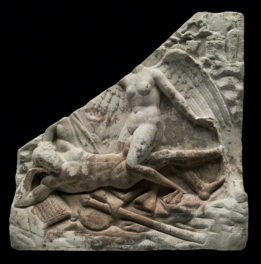Both the Getty Villa and the Getty Center have the good fortune of being adjacent to state parkland, and some of us make a point of getting out at lunch or after work to enjoy nearby hiking trails. We think our neighboring hillsides offer some of the most beautiful wilderness on the planet—gorgeous chaparral, California’s signature landscape. Today is the 40th annual Earth Day, an invitation to take a closer look at the nature in our back yard.

View from the trail in Los Liones Canyon in Topanga State Park
Chaparral is sometimes called dwarf or elfin forest, names that capture its intimate and even mysterious beauty. From afar, it strikes some people as an uninviting sea of olive drab. But enter the forest and you’ll find countless colors and forms that make up an inviting and complex world—leaves, stems, flowers, berries, and bark in shades of green, red, brown, and silver.
Bursts of color come in spring not only from annual wildflowers, such as the electric orange California poppy (our state flower), but also from lush new growth in silver, yellow green, and red encouraged by winter rains.

Laurel sumac (Malosma laurina) in a flush of new growth
Hiking trails near the Getty, such as the Getty View Trailhead just north of the Center on Sepulveda and the Los Liones Canyon Trail in Topanga State Park east of the Villa off Sunset, offer a journey through the chaparral’s fragrant shrubs and artfully twisted trees: coast live oak, California lilac, lemonadeberry, toyon, walnut, sage.
Many are richly aromatic, their oils an adaptation to our Mediterranean climate with its long, hot summers and short wet winters. In Topanga State Park, which has a variety of chaparral habitats as well as grassland, oak woodland, and coastal sage scrub, Los Angeles boasts the largest urban wildland in the world.
On a stroll through Los Liones Canyon this past Monday, I saw a sharp-shinned hawk, a baby cottontail, and a skunk, all within 400 yards of rush hour on Sunset. A painted lady caterpillar sauntered contentedly across the trail in the direction of the Villa, which was just closing for the evening.

Oaks aren’t always green: the growing tips of coast live oak (Quercus agrifolia) are tinged with gold and burgundy.
At the Getty Center, our east-facing hillside—the one you ride through on the tram—is covered with hundreds of coast live oaks, the classic evergreen tree of the Santa Monica Mountains. Look closely and you’ll notice new growth in startling hues of pink, peach, and lime green.
And keep your eye out for the apple-green shoots on our greenbark ceanothus, which is just finishing this spring’s marathon bloom of baby-blue.

Greenbark ceanothus (Ceanothus spinosus), with new stems against rugged old growth
It’s easy to picture wilderness as a far-off paradise—giant sequoias, let’s say, or deepest rainforest—certainly not the “scrub” lining the Sepulveda Pass. But enter that scrubscape and you’ll find a world of beauty that’s full of subtle surprises.




Thank you so much for sharing the beauty of Southern California. If I have any regrets, among them might be leaving California and not taking the job that was offered me by the Getty years ago. What a great museum. When I visit California it is one of my most important stops.